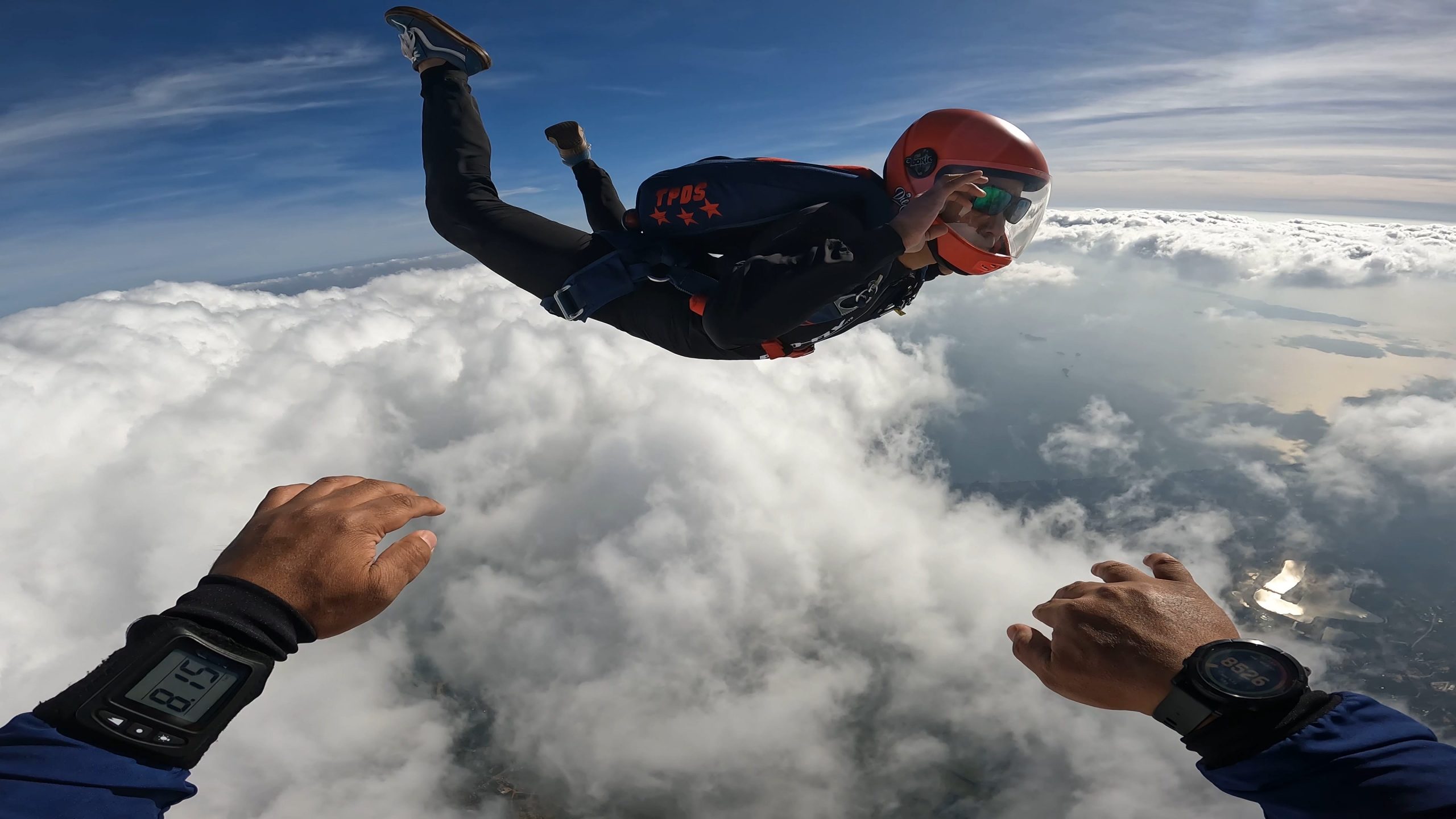Accelerated Freefall Course -AFF
Accelerated Freefall Course ( AFF Course)
Malaysia AFF course Key Features:
- Instructor Support: Students exit the aircraft with 1-2 USPA AFF-rated instructors who maintain physical contact via harness grips
- Immediate Freefall: Unlike static line or IAD methods, students experience full freefall from the first jump
- Progressive Training: Students advance through Categories A-H of the Integrated Student Program (ISP)
What is AFF (Accelerated Freefall) Course?
Want to experience real skydiving from your first jump? AFF is the way to go. Unlike other methods where you’re attached to a static line, with AFF you get the full freefall experience right away – with instructors holding onto you for safety, of course!
It’s called “accelerated” because you learn much faster. Instead of working your way up to freefall, you dive straight into it (literally) with expert guidance.
Why Choose Our AFF Training in Malaysia?
✅ USPA-Certified Training – International standard that’s recognized worldwide
✅ Equipment + Training Package – Learn to jump AND get your gear sorted
✅ Experienced Instructors – USPA AFF-rated instructors who know their stuff
✅ Local Support – We’re here for you even after you get your license
How the AFF Course Works
Ground School (The Learning Bit)
Before you jump, you’ll need to know the basics:
- How all the equipment works
- What to do in the plane
- Freefall body position and techniques
- What to do if things go wrong (spoiler: they rarely do)
- Flying your parachute and landing safely
The Jumping Part
Categories A-C: Getting Started
- Your first jumps with two instructors holding onto you
- Learning to stay stable in freefall
- Pulling your parachute at 5,500 feet
- Basic parachute flying and landing
Categories D-E: Getting Good
- Learning to turn in freefall
- Flying solo with just one instructor
- More challenging maneuvers
- Building confidence
Categories F-H: Almost There
- Jumping with other people
- Advanced parachute skills
- Emergency procedures under canopy
- Getting ready for your license
What You Need to Start
Age: 18 years old minimum
Health: Just need to be reasonably fit and healthy
Time: Usually takes about 8-10 jumps to get your AFF Done, depending on how quickly you pick it up
Equipment We Use
- Altimeter
- Helmets
- Complete parachute systems
- Jumpsuit
- All the gear you need for training
Want Your Own Gear? We’ve got everything from student equipment to advanced gear for licensed jumpers. Plus, everything comes with local warranty and support.
Why AFF is Better Than Other Methods
🎯 Real Freefall from Day One – No slow buildup, straight to the good stuff
🎯 Learn Faster – Your instructors are right there giving you feedback
🎯 Safer – Two instructors on your first few jumps
🎯 International License – Your USPA A-License works anywhere in the world
🎯 Better Foundation – You’ll be a more confident skydiver
Ready to Start Your AFF Course?
Here’s what happens next:
- Book your ground school – Learn everything you need to know
- First jump day – Two instructors, full freefall experience
- Keep progressing – Work through the 8 categories at your own pace
- Get your license – Join the worldwide skydiving community
- Keep jumping! – The fun really starts after you get licensed
Contact us via :
- Whatsapp – Click the whatsapp botton
- Email us
Common Questions About AFF Training
How long does it take? Most people finish in 1-2 weeks, but it depends on weather and how quickly you learn.
Is it scary? Sure, at first! But that’s part of the fun. Your instructors will make sure you’re safe.
What if I mess up? That’s what your instructors are for. They’ve seen it all and will help you through it.
Can I buy equipment during the course? Absolutely. We can help you choose the right gear for your experience level.
What happens after I get my license? The world opens up! You can jump anywhere, learn new skills, and maybe even compete.
🪂 USPA AFF Training Matrix
Accelerated Freefall Progression – Categories A through H
| Category | Jumps | Deployment Altitude |
Instructor Requirements |
Freefall Skills | Canopy Skills | Advancement Criteria |
|---|---|---|---|---|---|---|
| A (Arch) | 1 | 5,500 ft | 2 AFF Instructors required |
|
|
|
| B (Basics) | 1 | 5,500 ft | 2 AFF Instructors or 1 AFF I + Coach |
|
|
|
| C (Control) | 2 | 5,500 ft | Jump 1: 2 AFF Instructors Jump 2: 1 AFF Instructor |
|
|
|
| D (Direction) | 2 | 5,000 ft | 1 AFF Instructor |
|
|
|
| E (Explore) | 2 | 4,500 ft | 1 AFF Instructor or Coach (after cleared for self-supervision) |
|
|
|
| F (Flat Track) | 2 + 2 | 4,500 ft | Coach or Instructor supervision |
|
|
|
| G (Groups) | 3 | Breakoff: 5,500 ft Deploy by: 4,000 ft |
Coach supervision required |
|
|
|
| H (Hone) | 2 | Breakoff: 5,500 ft Deploy by: 4,000 ft |
Coach supervision |
|
|
|
📋 Legend & Notes
CEP: Canopy-flight Emergency Procedures (“Stay Alive, Practice Five”)
HAALR: Heading, Altitude, Arch, Legs, Relax
AIR: Altitude aware, In control, Relaxed
COA: Circle of Awareness
APT: Altitude, Position, Traffic
SPACE: Skydivers, Planes, Airport, Clouds, Exit light
SCS: Start-Coast-Stop technique
FAZ: Final Approach Zone
Red items are mandatory advancement criteria
Blue items are progression milestones
🎯 A-License Requirements Summary
- Total Jumps Required: Minimum 25 freefall jumps
- Accuracy Requirements: 5 landings within 65 ft (20m) of target
- Written Exam: 75% minimum score (40 questions)
- Oral Exam: 100% score required (20+ questions)
- Practical Exam: Check dive with USPA Instructor
- Self-Supervision: Cleared after Category E (2 disorienting maneuvers)

